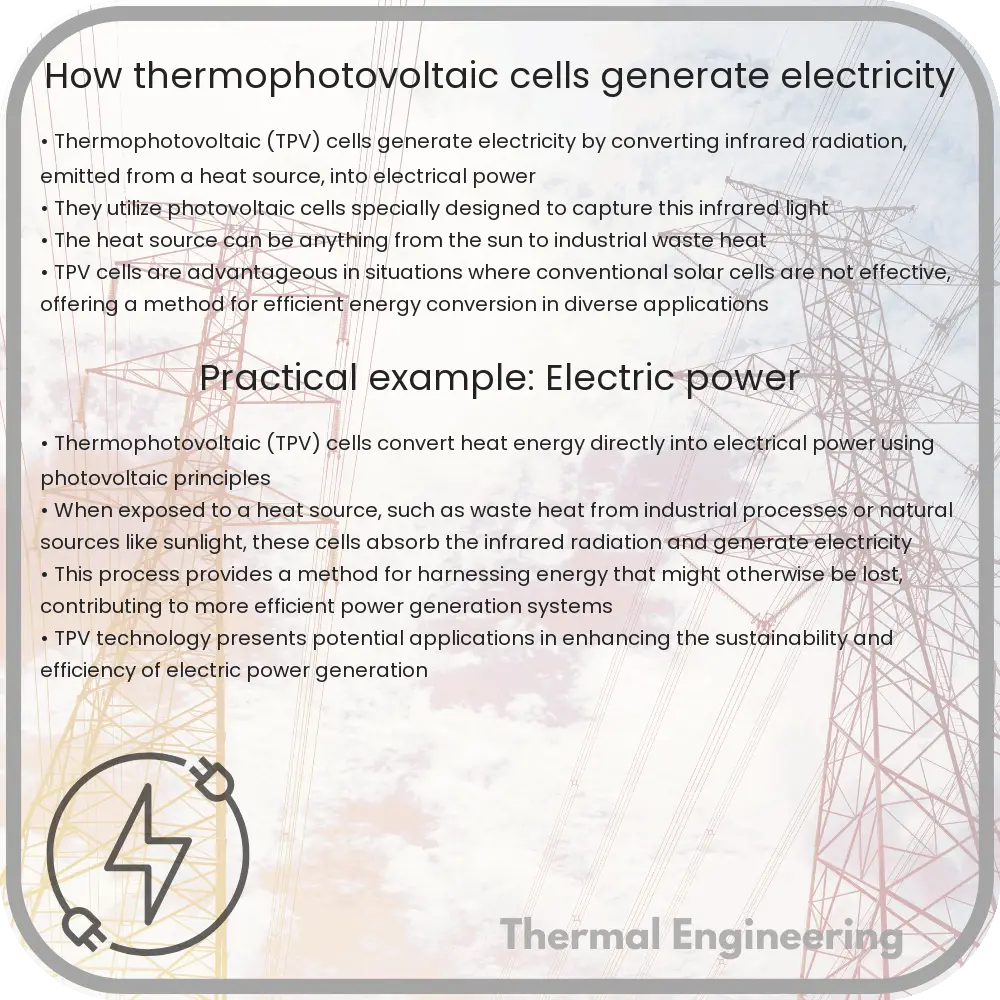Understand the workings of Thermophotovoltaic Cells (TPVs), which convert heat into electricity using a photovoltaic process for efficient energy solutions.

Introduction to Thermophotovoltaic Cells
Thermophotovoltaic (TPV) cells are devices that convert heat energy directly into electrical energy through a photovoltaic process, similar to how traditional solar cells work using sunlight. However, instead of relying on sunlight, TPV cells harness heat from different heat sources, converting it into electricity. This makes them valuable in applications where heat is abundantly available or as a method of improving the efficiency of systems that generate waste heat.
Basic Principle of TPV Cells
The fundamental mechanism behind thermophotovoltaic cells revolves around the concept of heat-induced photon emission. When any material is heated to high temperatures, it starts to emit light—this phenomenon is known as thermal radiation. TPV cells use this radiated light to generate electricity using materials that are sensitive to particular wavelengths of light.
Components of a TPV System
- Heat Source: Provides thermal energy to the system which can be natural (like geothermal) or waste heat from industrial processes.
- Emitter: A component that absorbs thermal energy from the heat source and re-radiates it in the form of light suitable for the photovoltaic cell.
- Photovoltaic Cells: These cells are specially designed to convert the light emitted from the emitter into electricity. They are typically made from materials like gallium antimonide (GaSb) which are efficient at absorbing the infrared light emitted by hot emitters.
- Filter: In some setups, a filter is used to reflect unusable wavelengths back to the emitter, thus enhancing the overall efficiency by ensuring only useful wavelengths reach the photovoltaic cell.
How TPV Cells Generate Electricity
The process begins when the heat source provides energy to the emitter. Consequently, the emitter heats up and starts radiating photons. These photons are directed towards the photovoltaic cells. When these photons strike the photovoltaic cells, they are absorbed, causing electron-hole pairs to form within the cell’s semiconductor material. Similar to traditional solar panels, these electron-hole pairs create an electric current as they move towards different charges in the cell.
Efficiency and Applications
One of the critical challenges for TPV systems is efficiency. Factors such as the temperature of the emitter and the spectral match between emitter radiation and cell absorption significantly affect the system’s performance. Enhancements in materials science, especially the development of better emitters and PV cells that can operate efficiently at various wavelengths, are integral to improving TPV efficiency.
Applications of thermophotovoltaic cells span across various fields. In space exploration, they can provide power by converting heat from radioisotope thermoelectric generators. In industrial settings, TPV systems can convert waste heat from furnaces, engines, or even incinerators into additional electrical power. This not only helps in energy recovery but also in reducing overall carbon emissions.
Conclusion
Thermophotovoltaic cells offer a promising technology for converting heat to electricity, especially in scenarios where capturing waste heat is feasible. While the technology is still under development and facing efficiency challenges, ongoing research in materials and system designs holds the promise of making TPV an essential component of future sustainable energy solutions.